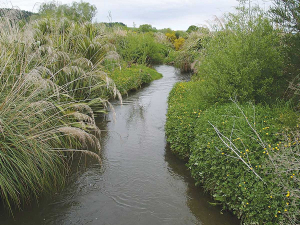Simon Upton urges cross-party consensus on New Zealand environmental goals
Parliamentary Commissioner for the Environment Simon Upton is calling for cross-party consensus on the country's overarching environmental goals.
 More than 600km of Taranaki river and stream banks will be planted with a million native plants next winter.
More than 600km of Taranaki river and stream banks will be planted with a million native plants next winter.
More than 600km of Taranaki river and stream banks will be planted with a million native plants next winter as the region’s farmers take advantage of a $5 million government boost.
The funding for the Transforming Taranaki riparian management programme will allow eligible farmers to buy native plants for $1 each, create 80 new jobs and bring environmental benefits to the entire region.
The Taranaki Regional Council scheme has been running for 27 years, with farmers voluntarily planting and fencing thousands of kilometres of waterways. In that time Council officers have prepared nearly 3,000 individual riparian plans, and more than 6.2 million plants have been distributed at cost.
The programme’s goal is improved water quality and an increase in biodiversity, with the plants providing habitat for native birds and cover for aquatic species.
About 900,000 plants are being contract-grown for the 2021 winter planting season. The opportunity to buy $1 plants will be offered to Council plan holders in the intensively farmed zone of the Taranaki ring plain and coastal marine terraces, with priority given to those who have demonstrated a strong commitment to riparian planting and fencing over the years.
If eligible, they can order between 500 and 2,000 plants per plan.
The cost includes planting by Council-arranged contractors, whereas previously that had been the responsibility of the landowner. Plan holders will be required to erect fences to protect the plants, estimated to be worth $4.1 million. The value of the combined fencing and planting is expected to be near $10.8 million.
Council land services manager Don Shearman says the funding is great news for the region.
“Taranaki farmers have put in years of hard work planting and fencing their waterways all at their own cost – because they know it’s the right thing to do. And many are now so close to completing their plans.
“This funding will save them thousands of dollars, plus precious time, allowing them to push forward to the finishing line.
“We’re already seeing environmental benefits from the programme, with a NIWA study last year finding many Taranaki sites had the best water quality they’d had since 1995. We’re excited to see the improvements continue.”
The $5 million came from the Public Waterways and Ecosystem Restoration Fund, administered by the Ministry for the Environment. It is part of the Government’s wider Jobs for Nature Programme, part of its COVID-19 recovery package.
Fears of a serious early drought in Hawke’s Bay have been allayed – for the moment at least.
There was much theatre in the Beehive before the Government's new Resource Management Act (RMA) reform bills were introduced into Parliament last week.
The government has unveiled yet another move which it claims will unlock the potential of the country’s cities and region.
The government is hailing the news that food and fibre exports are predicted to reach a record $62 billion in the next year.
The final Global Dairy Trade (GDT) auction has delivered bad news for dairy farmers.
One person intimately involved in the new legislation to replace the Resource Management Act (RMA) is the outgoing chief executive of the Ministry for the Environment, James Palmer, who's also worked in local government.
President Donald Trump’s decision to impose tariffs on imports into the US is doing good things for global trade, according…
Seen a giant cheese roll rolling along Southland’s roads?